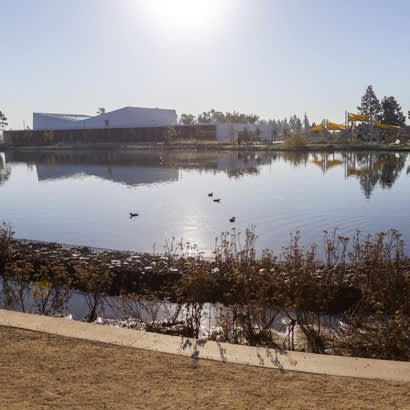
Pictured: Earvin “Magic” Johnson Recreation Area in Los Angeles, California.
As part of its Earth Day celebrations in April, the Los Angeles County Department of Parks and Recreation (DPR) hosted screenings of the film Common Ground at two regional parks: Kenneth Hahn State Recreation Area and Whittier Narrows Recreation Area. The subject of this documentary is “regenerative agriculture,” which is essentially a conservation and rehabilitation approach to land management and food production. Unlike industrial agriculture, the regenerative version focuses on topsoil regeneration, enhancing ecosystem services, improving the water cycle, increasing biodiversity and resilience to climate change, supporting bio-sequestration, and strengthening soil health and vitality.
While Common Ground is primarily about food production and farming systems, the movie should also prompt and inspire viewers to think and act more broadly and globally about our relationship with the land and the need to heal it. For example, the idea of land regeneration aligns with the need and urgency to transform additional degraded lands such as brownfields and oilfields into parks, open space, community gardens, and other land uses that generate multiple benefits to communities, especially those that are most vulnerable to the effects of climate change.
30x30 and the Parks Needs Assessment Plus
In recent years, there has been much discussion and some commitments made at various levels of government to achieve “30x30,” the goal of conserving 30 percent of lands and coastal waters by the year 2030 to fight climate change, advance conservation and protect biodiversity. Aligning with and expanding on these efforts, the L.A. County Board of Supervisors unanimously adopted the 2022 Parks Needs Assessment Plus (PNA+) final report as the county’s 30x30 plan on December 6, 2022.
The PNA+ reimagines conservation through an equity lens to include both the protection of natural lands and the restoration of degraded lands, especially in lower-income communities of color where vulnerable populations and environmental burdens are concentrated. Priority areas for restoration are those that have the most environmental burdens with respect to groundwater threat, hazardous waste, poor air and water quality, and pollution burden. Examples include oil fields, brownfields, landfills, and other degraded lands that may be converted to parks and open spaces in the future.
In coordination and collaboration with regional conservancies and a coalition of community-based organizations, DPR is in the process of implementing the recommendations of the PNA+. This has included pursuing changes to policies and funding programs to facilitate and support the restoration of degraded lands as well as planning and developing new parks on challenging sites in high need and vulnerable communities identified in the 2016 Parks Needs Assessment (PNA) and the 2022 PNA+.
Regeneration through Parks
DPR recognizes that parks are not just spaces of leisure and recreation; they are also sanctuaries of nature’s resilience and human hope. The creation of new parks, especially in areas scarred by industrialization, urbanization, and/or environmental degradation, can serve as a transformative force, regenerating both the land and the communities that surround it. A prime example of this is the transformation of Earvin “Magic” Johnson Recreation Area which lies on the site of an oil storage facility that was in operations until 1963.
One of the primary benefits of creating new parks is the revitalization of degraded or abandoned land. Former industrial sites, landfills, and other damaged areas can be transformed into vibrant green spaces, teeming with biodiversity. Through thoughtful planning and restoration efforts, these parks can help heal the land, improving soil quality, restoring native vegetation, and creating habitats for wildlife. This regeneration not only improves the aesthetics of the area but also contributes to the health of the ecosystem and mitigates environmental damage.
Moreover, new parks can serve as catalysts for community regeneration and social healing. By providing accessible green spaces, parks can improve the quality of life for residents, offering opportunities for exercise, relaxation, and social interaction. In urban areas, where green spaces are often limited, new parks can act as lungs for the community, providing much-needed respite from the concrete jungle. These spaces can also foster a sense of community pride and ownership, as residents come together to care for and enjoy the parks.
Additionally, new parks can play a crucial role in environmental education and awareness. By showcasing sustainable practices such as native plant landscaping, rainwater harvesting, and wildlife conservation, these parks can inspire visitors to adopt more environmentally friendly behaviors in their own lives. Education programs and interpretive signage can further enhance visitors’ understanding of the natural world, fostering a deeper connection to the land and a greater appreciation for its importance.
Conclusion
The creation of new parks represents a powerful way to regenerate both the land and the communities that inhabit it. By restoring damaged landscapes, providing valuable green spaces, and fostering environmental education and awareness, parks can play a significant role in healing the land and building more sustainable and resilient communities. As we look to the future, investing in the creation of new parks should be seen not just as another expenditure but as a vital investment in our collective well-being and the health of our planet.
Clement Lau, DPPD, FAICP, is a Departmental Facilities Planner with the Los Angeles County Department of Parks and Recreation.

